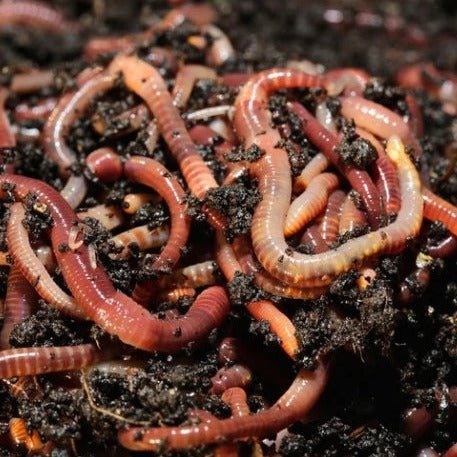Red Wiggler Express: The Best Source for Fresh Worms and Bait
Red Wiggler Express: The Best Source for Fresh Worms and Bait
Blog Article
Red Wigglers 101: Every Little Thing You Need to Know for Thriving Gardens
Red wigglers, or Eisenia fetida, play a vital duty in sustainable horticulture methods, functioning as reliable decomposers that convert organic waste right into important vermicompost. Understanding their habitat, dietary choices, and the myriad benefits they offer can change your gardening strategy (Red Wiggler Express). As these worms prosper in specific conditions, their treatment and management are vital for maximizing their contributions to soil wellness. The inquiry stays: what steps can you take to harness the full potential of these impressive organisms in your own yard?
Recognizing Red Wigglers

Red wigglers thrive in atmospheres rich in natural material and wetness. Red Wiggler Express. They possess an unique digestion system that permits them to refine food scraps promptly, excreting castings that are packed with necessary nutrients such as nitrogen, phosphorus, and potassium. These spreadings enhance soil structure, enhance water retention, and foster beneficial microbial activity, all of which add to durable plant health and wellness
Furthermore, red wigglers can survive in diverse problems, making them versatile to various gardening methods, including interior and outdoor composting systems. Their ability to consume big amounts of natural waste day-to-day placements them as important allies for both home garden enthusiasts and commercial cultivators. By integrating red wigglers into horticulture initiatives, one can considerably boost soil fertility and assistance lasting horticulture practices.
Ideal Environment for Red Wigglers
Creating an ideal setting for red wigglers is vital for maximizing their composting capabilities and general health and wellness. Red wigglers flourish in moist, dark, and well-aerated environments, which carefully resemble their all-natural atmospheres in ground cover and decomposing natural issue. An appropriate environment ought to offer a temperature level range between 55 ° F and 77 ° F(13 ° C to 25 ° C), as extreme temperatures can worry or damage the worms.
The bed linens material, such as shredded paper, cardboard, or coconut coir, should be kept damp but not overly damp, as extreme moisture can lead to anaerobic problems destructive to worm health and wellness. Additionally, a pH level between 6.0 and 7.5 is optimal, ensuring a well balanced environment.
Proper aeration is equally essential; it enables oxygen circulation and stops the buildup of damaging gases. A container or container made for vermicomposting should have water drainage openings to remove excess moisture and advertise air flow. Routine tracking of these problems is important for preserving a growing red wiggler population, inevitably improving their performance in damaging down natural waste and enriching garden soil.
Dietary Needs and Preferences

Red wigglers exhibit specific choices; they are especially warm of softer, decaying products over more challenging or even more fibrous compounds. It is essential to stay clear of feeding them citrus peels, onion, and garlic in large quantities, as these can be hazardous. Furthermore, meat, milk, and oily foods should be excluded, as they can attract parasites and develop undesirable odors.
(Lake Rhodhiss Bait)To maintain ideal health, a well balanced mix of eco-friendly and brown materials is suggested. Green products, such as veggie scraps, provide nitrogen, while brown products, like cardboard and dried fallen leaves, supply carbon. Keeping an eye on the moisture material and ensuring a regular food supply will better boost their development and composting abilities. By accommodating their dietary requirements, garden enthusiasts can foster a growing population of red wigglers in their compost systems.
Advantages of Making Use Of Red Wigglers
The amazing benefits of using red wigglers in gardening prolong far beyond their duty in composting. These versatile microorganisms contribute significantly to soil health, improving vitamins and mineral availability and promoting microbial task. By aerating the soil as they delve, red wigglers improve drain and origin penetration, creating an ideal environment for plant growth.
Moreover, red wigglers are effective recyclers of organic waste, converting it right into nutrient-rich spreadings that act as an exceptional natural fertilizer. These spreadings include valuable bacteria and necessary nutrients, such as nitrogen, phosphorus, and potassium, which are vital for plant advancement. The slow-moving launch of nutrients from worm spreadings makes sure a stable supply, decreasing the risk of nutrient leaching and promoting lasting gardening techniques.
Making use of red wigglers fosters a much more lasting horticulture technique by decreasing reliance on chemical plant foods and promoting a closed-loop system, where waste is changed into important sources. Overall, integrating red wigglers into gardening methods uses a multitude of ecological and farming benefits.
(Charlotte NC Worms For Sale)
Composting With Red Wigglers

To initiate a successful vermicomposting system, select an appropriate container with proper air flow and drainage. The perfect setting for red wigglers includes a wet, dark setting with temperatures between 55 ° F and 77 ° F. Begin by layering shredded paper, cardboard, and food scraps, ensuring a balanced mix of carbon and nitrogen-rich products.
Red wigglers grow on veggie peels, fruit scraps, coffee premises, and eggshells, while preventing meat, dairy products, and oily foods that can attract insects. Frequently keep an eye on dampness levels; the bedding must perspire yet click for more info not soggy. Harvest worm spreadings every few months by dividing the worms from the compost, which can after that be made use of straight in gardens or saved for later usage.
Applying vermicomposting not just decreases land fill waste however additionally enriches yard dirt, advertising healthy and balanced plant growth and lasting horticulture techniques. Embrace this green method to enhance your horticulture undertakings.
Verdict
In recap, red wigglers are essential organisms for enhancing garden productivity with reliable composting. Their specific environment demands, nutritional preferences, and considerable advantages add to lasting horticulture methods. By utilizing red wigglers, garden enthusiasts can substantially improve dirt high quality and nutrient availability, promoting healthier plant development. Welcoming the technique of vermicomposting not only supports waste decrease but also promotes an eco-friendly equilibrium within yard environments, ultimately causing growing and durable yards.
Report this page